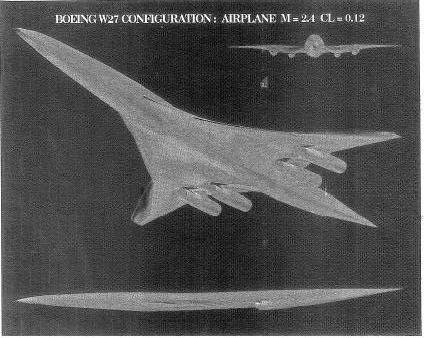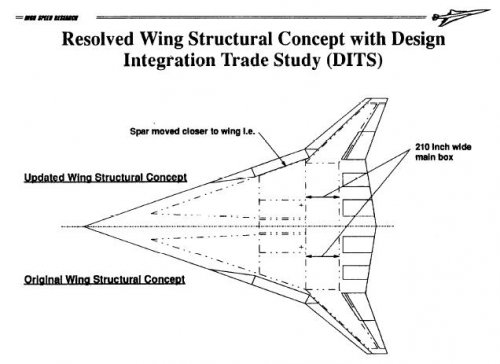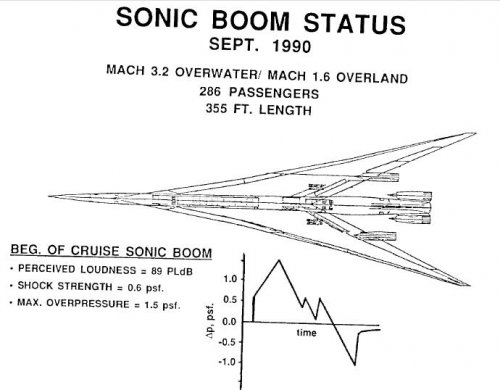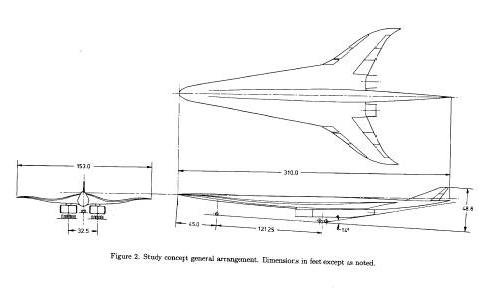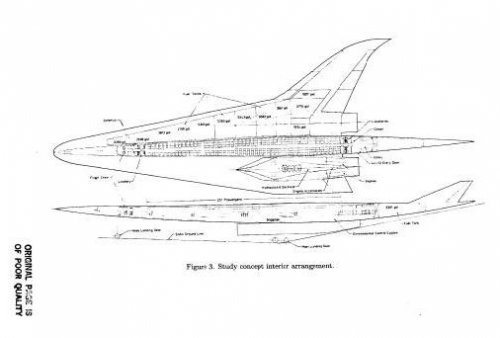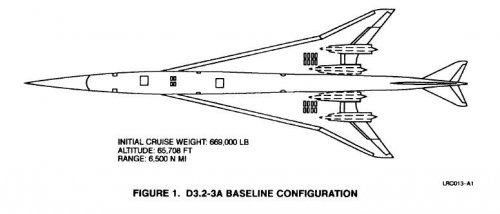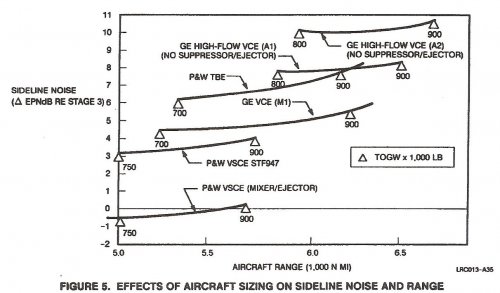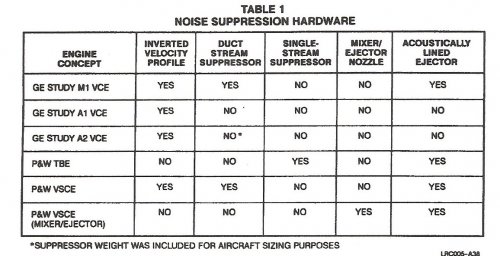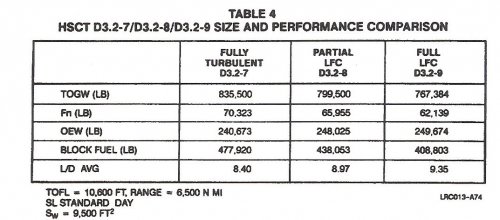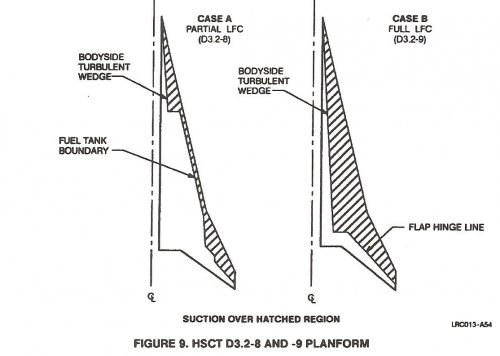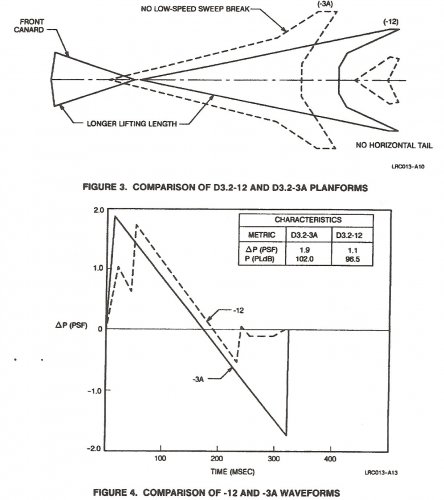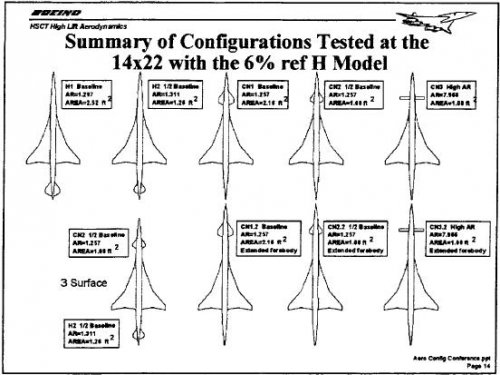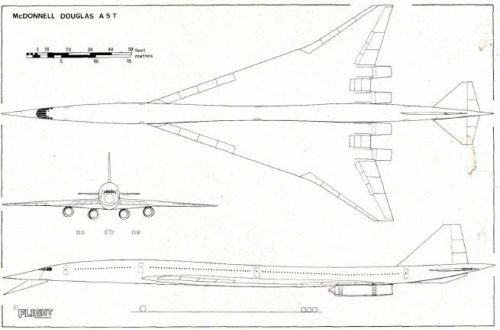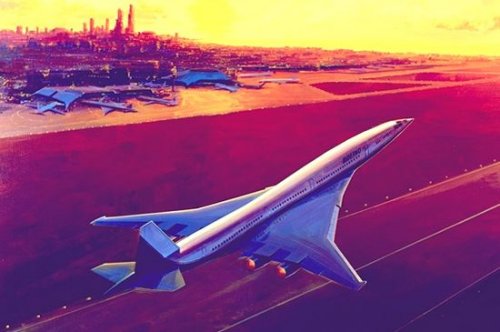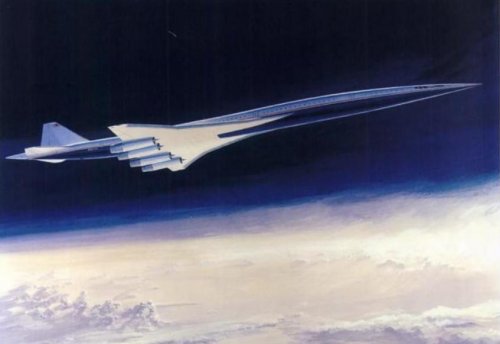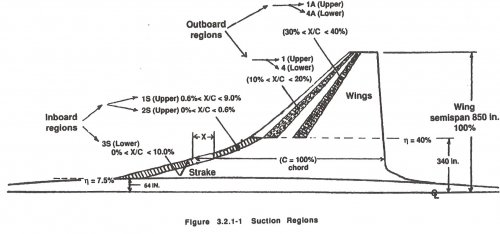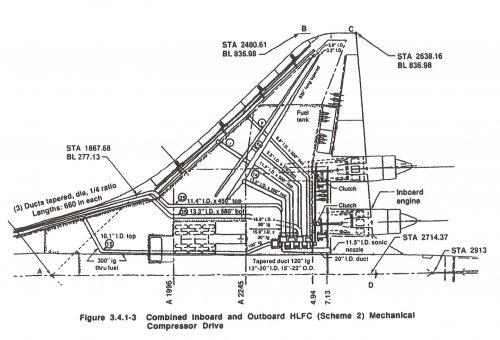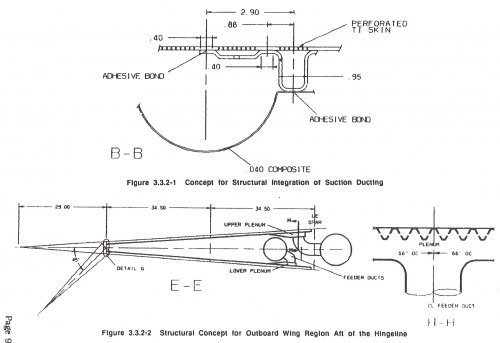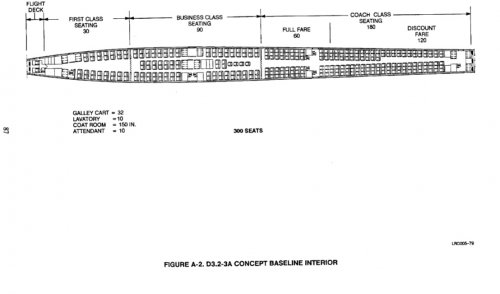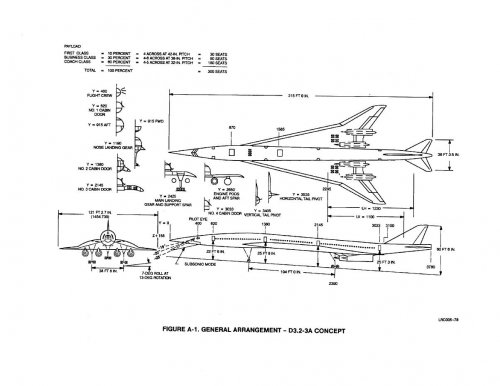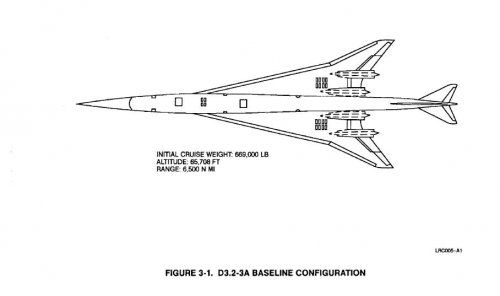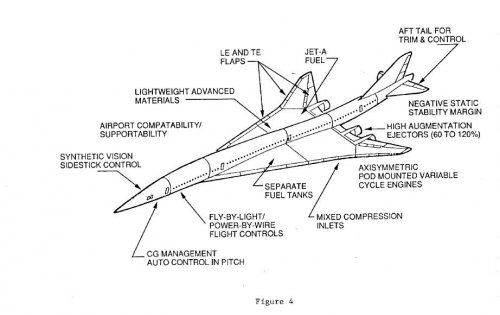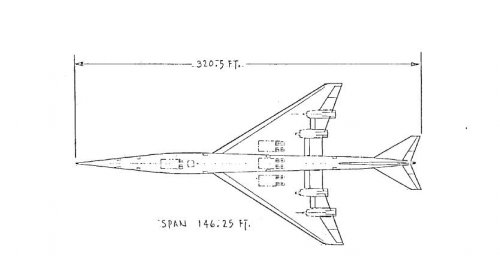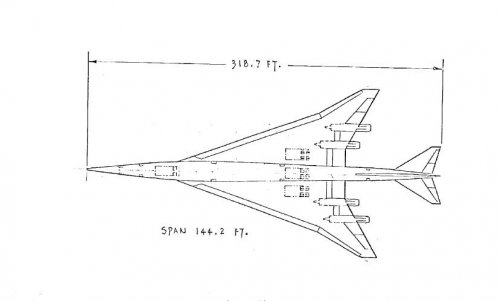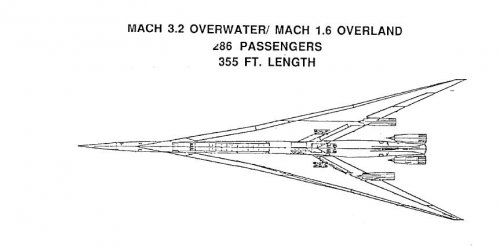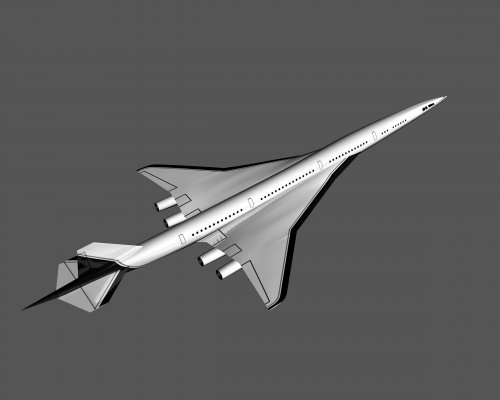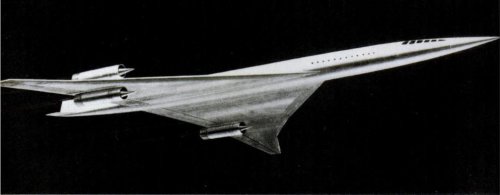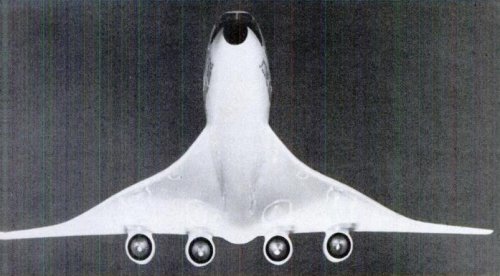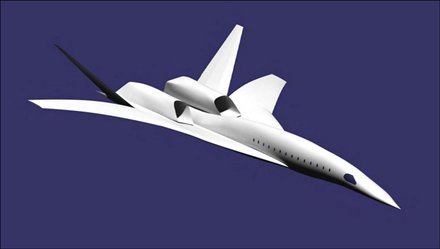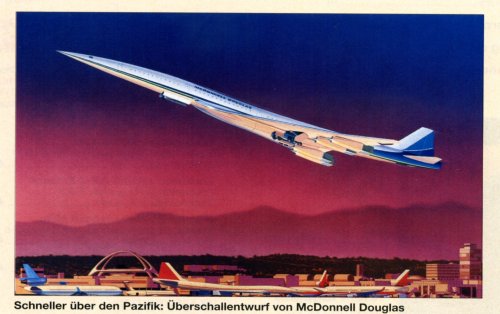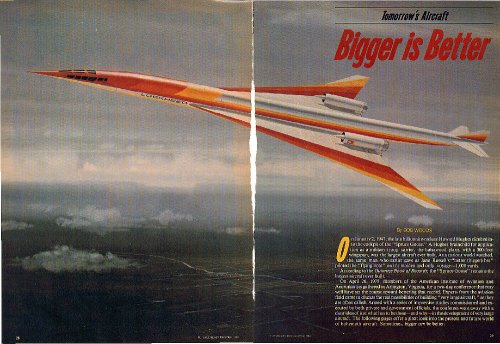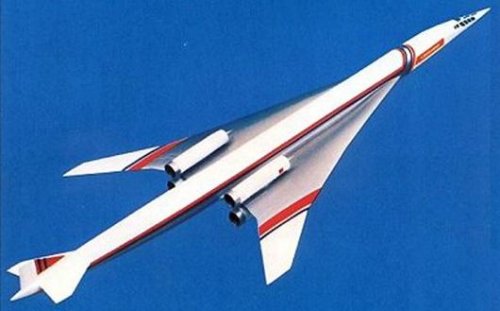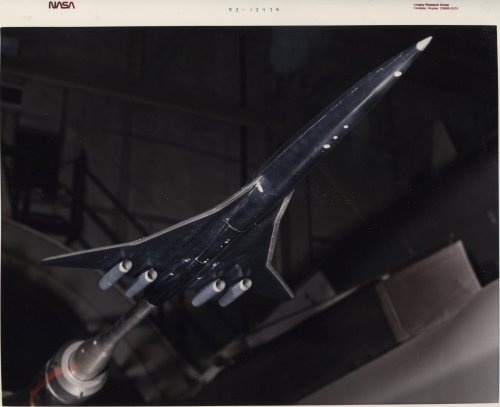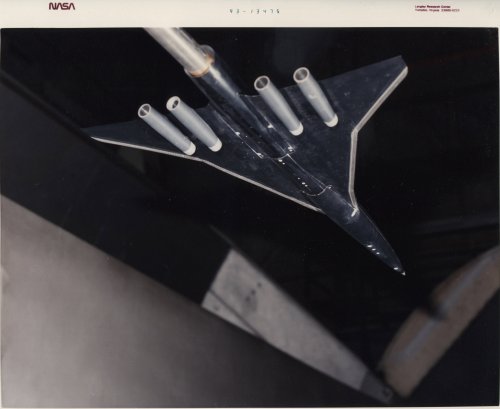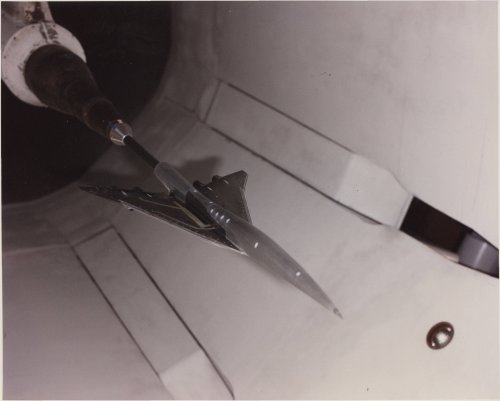You are using an out of date browser. It may not display this or other websites correctly.
You should upgrade or use an alternative browser.
You should upgrade or use an alternative browser.
US Supersonic Transport(SST) Program post-1971
- Thread starter Sundog
- Start date
KJ_Lesnick
ACCESS: Top Secret
- Joined
- 13 February 2008
- Messages
- 1,042
- Reaction score
- 114
I think they should have got rid of the canard and instead made a long strake at the front. Think L-2000 meets F-108 Rapier *drools*
blackkite
Don't laugh, don't cry, don't even curse, but.....
- Joined
- 31 May 2007
- Messages
- 8,820
- Reaction score
- 7,721
Hi hesham!
Thank very much for very interesting report.
McDonnell Douglas M3.2 SST study in1991.
Cruising speed:M3.2
Cruising altitude:65,708ft
Initial cruising weight:669,200lb
Range:6,500n.m
Canard shape for sonic boom reduction is very radical.
This study include LFC system study and noise evaluation for some engine type.
Thank very much for very interesting report.
McDonnell Douglas M3.2 SST study in1991.
Cruising speed:M3.2
Cruising altitude:65,708ft
Initial cruising weight:669,200lb
Range:6,500n.m
Canard shape for sonic boom reduction is very radical.
This study include LFC system study and noise evaluation for some engine type.
Attachments
blackkite
Don't laugh, don't cry, don't even curse, but.....
- Joined
- 31 May 2007
- Messages
- 8,820
- Reaction score
- 7,721
Supersonic Cruise Technology by F Edward McLean, NASA, 1995.
http://ntrs.nasa.gov/archive/nasa/casi.ntrs.nasa.gov/19850020600_1985020600.pdf
http://ntrs.nasa.gov/archive/nasa/casi.ntrs.nasa.gov/19850020600_1985020600.pdf
All beatiful concepts !!! 

I have impression that after crash of Concorde Flight 4590 in 2000 , all dreams about supersonic trasport seems gone !
http://en.wikipedia.org/wiki/Boeing_2707
http://en.wikipedia.org/wiki/Lockheed_L-2000
I have impression that after crash of Concorde Flight 4590 in 2000 , all dreams about supersonic trasport seems gone !
http://en.wikipedia.org/wiki/Boeing_2707
http://en.wikipedia.org/wiki/Lockheed_L-2000
blackkite
Don't laugh, don't cry, don't even curse, but.....
- Joined
- 31 May 2007
- Messages
- 8,820
- Reaction score
- 7,721
Hi! Last year I saw JAXA rocket lunched Mach 2 glider for SST technology verificaiton, there are no suction holes at leading edge of the wing. It's natural laminar flow wing. Natural means no additional devices are needed for laminar flow.PNorwood said:blackkite,
I was under the impression that you would require boundary flow suction on the leading edge with the rest of the wing designed as a natural laminar-flow wing
blackkite said:Hi! Last year I saw JAXA rocket lunched Mach 2 glider for SST technology verificaiton, there are no suction holes at leading edge of the wing. It's natural laminar flow wing. Natural means no additional devices are needed for laminar flow.
That's highly impressive
blackkite
Don't laugh, don't cry, don't even curse, but.....
- Joined
- 31 May 2007
- Messages
- 8,820
- Reaction score
- 7,721
Hi JAXA's Mach 2 glider.
It has natural laminar flow wing.
http://www.secretprojects.co.uk/forum/index.php/topic,5044.0.html
It has natural laminar flow wing.
http://www.secretprojects.co.uk/forum/index.php/topic,5044.0.html
The 1989 High-Speed Civil Transport Studies by HSCT Concept Development Group,
Advanced Commercial Programs, Douglas Aircraft Company, Long Beach, California 1991
Abstract:
http://ntrs.nasa.gov/archive/nasa/casi.ntrs.nasa.gov/19910014882_1991014882.pdf
Advanced Commercial Programs, Douglas Aircraft Company, Long Beach, California 1991
Abstract:
The results are presented for the Douglas Aircraft Company system studies related to high speed civil transports (HSCTs). The system studies were conducted to assess the environmental compatibility of a HSCT at a design Mach number of 3.2. Sonic boom minimization, exterior noise, and engine emissions were assessed together with the effect of a laminar flow control (LFC) technology on vehicle gross weight. The general results indicated that (1) achievement of a 90 PLdB sonic boom loudness level goal at Mach 3.2 may not be practical; (2) the high flow engine cycle concept shows promise of achieving the side line FAR Part 36 noise limit but may not achieve the aircraft range design goal of 6,500 nautical miles; (3) the rich burn/quick quench (RB/QQ) combustor concept shows promise for achieving low EINO(sub x) levels when combined with a premixed pilot stage/advanced technology high power stage duct burner in the P and W variable stream control engine (VSCE); and (4) full chord wing LFC has significant performance and economic advantages relative to the turbulent wing baseline.
http://ntrs.nasa.gov/archive/nasa/casi.ntrs.nasa.gov/19910014882_1991014882.pdf
Attachments
Douglas Aircraft HSCT Status and Future Research Needs by H. Robert Welge, Douglas Aircraft Company, April 1992
http://ntrs.nasa.gov/archive/nasa/casi.ntrs.nasa.gov/19940028948_1994028948.pdf
Current activities on the High Speed Civil Transport (HSCT) at Douglas are focussed on baseline vehicle development at Mach 1.6 and 2.4. Parallel design activities incorporating the latest technologies in structures/materials, propulsion/noise, and aerodynamics are also being conducted and incorporated into the baseline to establish performance, economic viability, and environmental compliance. Studies are also being conducted to establish the feasibility of incorporating laminar flow control and minimized sonic boom concepts into the baseline. A decision point on these last two technologies is targeted prior to the start of the NASA HSR Phase 2 Program in 1993.
http://ntrs.nasa.gov/archive/nasa/casi.ntrs.nasa.gov/19940028948_1994028948.pdf
Attachments
Steve Pace
Aviation History Writer
- Joined
- 6 January 2013
- Messages
- 2,266
- Reaction score
- 225
Artist's impression of Lockheed SST concept circa 1979. Engines are mounted over and under the wing. Noise from lower engines masks that from the upper ones. It also leaves more wing surface free for control flaps, so wings can be smaller. Lockheed used a modified blended body; passengers in the midsection do not have windows.
Source: "New Aerodynamic Design, New Engines, Spawn a Revival of the SST" by Jim Shefter, Popular Science, July 1979.
Source: "New Aerodynamic Design, New Engines, Spawn a Revival of the SST" by Jim Shefter, Popular Science, July 1979.
Attachments
- Joined
- 22 January 2006
- Messages
- 4,216
- Reaction score
- 2,018
Source: "New Aerodynamic Design, New Engines, Spawn a Revival of the SST" by Jim Shefter, Popular Science, July 1979.
I think that's not a Boeing SST but a Boeing fighter design.
Please anybody can confirm my words?
Thanks,
Antonio
- Joined
- 2 August 2006
- Messages
- 3,256
- Reaction score
- 1,529
Triton said:Model of Boeing SST concept circa 1979 with blended body. The blended body means that there are no windows in the passenger compartment. Passengers would have video monitors at each seat offering entertainment programs or outside views.
I've seen the engineering drawings for that concept as a two seat demonstrator/interceptor for the USAF, back when I was in school in the '80's, (Also see pometablava's reply above for the renderings) and if you check the patent drawings for the design it's for a supersonic bizjet.
See the patent here
Oh dear! Popular Science got it wrong. :-[ I found a report after posting from the NASA Technical Reports Server that describes the Boeing design as a supersonic demonstrator. It just isn't big enough to be a supersonic airliner.
- Joined
- 26 May 2006
- Messages
- 34,922
- Reaction score
- 15,794
Hi,
the Boeing SST.
http://www.aviationweek.com/aw/blogs/aviation_week/on_space_and_technology/index.jsp?plckController=Blog&plckBlogPage=BlogViewPost&newspaperUserId=a68cb417-3364-4fbf-a9dd-4feda680ec9c&plckPostId=Blog:a68cb417-3364-4fbf-a9dd-4feda680ec9cPost:07856d18-29c1-411d-aa9f-6f6c9af19b3d&plckScript=blogScript&plckElementId=blogDest
the Boeing SST.
http://www.aviationweek.com/aw/blogs/aviation_week/on_space_and_technology/index.jsp?plckController=Blog&plckBlogPage=BlogViewPost&newspaperUserId=a68cb417-3364-4fbf-a9dd-4feda680ec9c&plckPostId=Blog:a68cb417-3364-4fbf-a9dd-4feda680ec9cPost:07856d18-29c1-411d-aa9f-6f6c9af19b3d&plckScript=blogScript&plckElementId=blogDest
Attachments
- Joined
- 2 August 2006
- Messages
- 3,256
- Reaction score
- 1,529
The inward leaning intakes are just aligning themselves with the airflow over the top of the wing.Stargazer2006 said:Nice, but the inward leaning intakes are extremely strange, I dare say...
XP67_Moonbat
ACCESS: Top Secret
- Joined
- 16 January 2008
- Messages
- 2,272
- Reaction score
- 544
High-Speed Flight and the Military
A 1999 assessment of the HSCT for military use.
http://handle.dtic.mil/100.2/ADA397157
A 1999 assessment of the HSCT for military use.
http://handle.dtic.mil/100.2/ADA397157
- Joined
- 1 November 2009
- Messages
- 638
- Reaction score
- 429
Model of Lockheed SST concept.
Source: http://www.fabiofeminofantascience.org/RETROFUTURE/RETROFUTURE6.html
Source: http://www.fabiofeminofantascience.org/RETROFUTURE/RETROFUTURE6.html
Attachments
Supersonic transport aircraft concept incorporating a natural laminar flow wing and thermal laminar flow control (courtesy of Northrop Grumman and Aeronautical Systems Analysis Division, NASA Langley).
Source: http://www.aee.odu.edu/fas.php?id=3
Source: http://www.aee.odu.edu/fas.php?id=3
Attachments
- Joined
- 25 June 2009
- Messages
- 14,757
- Reaction score
- 6,158
Boeing's HSCT (described elsewhere as Model 1080) appears in model form in four pictures released by NASA. Description is "Boeing 1873 Reference H HSCT Force Model", whatever that means.
http://crgis.ndc.nasa.gov/historic/Test_457:_Boeing_1873_Reference_H_HSCT_Force_Model
http://crgis.ndc.nasa.gov/historic/Test_457:_Boeing_1873_Reference_H_HSCT_Force_Model
Attachments
- Joined
- 25 June 2009
- Messages
- 14,757
- Reaction score
- 6,158
NASA's wind tunnel photos aoso contain a picture of an HSCT-type project by McDonnell Douglas, described as "McDonnell Douglas M 2-4-7a OPT 5 (HSR CA-17)", for what it's worth!
http://crgis.ndc.nasa.gov/historic/Test_470:_McDonnell_Douglas_M_2-4-7a_OPT_5_%28HSR_CA-17%29
http://crgis.ndc.nasa.gov/historic/Test_470:_McDonnell_Douglas_M_2-4-7a_OPT_5_%28HSR_CA-17%29
Attachments
OM
ACCESS: Top Secret
Triton said:
...And here I thought Mooney had the patents locked up on the backwards tailfin ;D ;D
Similar threads
-
US Supersonic Transport (SST) Program 1960-1971
- Started by Orionblamblam
- Replies: 2K
-
-
1990 high speed civil transportation studies
- Started by ford_tempo
- Replies: 1
-
CalPoly « Horizon » Blended Wing Aircraft (NASA/USRA advanced design program)
- Started by Stargazer
- Replies: 3
-

